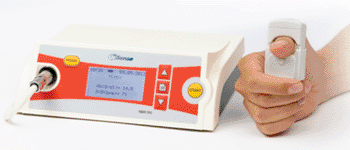Noninvasive Occlusion Spectroscopy Assessed for Blood Banks
By LabMedica International staff writers
Posted on 05 Jun 2013
The feasibility of using noninvasive occlusion spectroscopy method in a blood bank to determine hemoglobin (Hb) levels has been compared with standard methods. Posted on 05 Jun 2013
The tests used for anemia screening in blood donors are based on phlebotomy samples, leading to discomfort and complaint, which can be avoided by using occlusion spectroscopy that makes the procedure more comfortable and could therefore contribute to greater donor retention.

Image: Occlusion spectroscopy NBM200 (Photo courtesy of OrSense).
Hematologists at the University of Campinas (Brazil) enrolled 205 consecutive volunteer blood donors of whom, 136 were males and 69 females with an age range of 18 to 65 years, with the median at 32 years. Samples were collected by fingerstick and venous puncture to determine Hb level by a photometer (Hb-F) and automatic blood analyzer (Hb-V) and compared to the noninvasive Hb (Hb-NI) determination by occlusion spectroscopy (Orsense Ltd.; Nes Ziona, Israel).
The Hb-NI determination was performed by pressure applied by a ring-shaped multiwave length sensor probe containing a pneumatic cuff that temporarily occludes the blood flow in the base of the finger and generates a strong optical signal, yielding a high signal-to-noise ratio that is wholly blood specific. Analysis of the signal in the wavelength range of 600 to 1,500 nm provides the necessary sensitivity for measuring Hb concentration and pulse rate. The test is performed in 90 seconds, and is far more comfortable for the donors than phlebotomy.
The results obtained with Hb-F using the Hemocue Hb201+ (Ängelholm, Sweden) showed significant above value differences in the general group as well as when stratified by sex, weight, and age groups, than those obtained with Hb-V using the CellDyn Ruby automatic analyzer (Abbott Laboratories, Abbott Park, IL, USA ). There were significant differences between Hb-NI that were below Hb-V values when measured using the NBM200 occlusion spectroscopy method, but only in females and weight levels between 61 kg to 70 kg.
The authors concluded that the Hb-NI is a feasible and noninvasive to screen donors. It is safe, easy to perform, and quick and does not require extremely specialized technicians. It may also be used in mobile units due to its portability and may be used with power supply or batteries, which allows approximately 100 tests per battery. An issue that should be considered is the higher cost per test of Hb-NI, about USD 1.13 compared to the Hb-F at around USD 0.50. The study was published in the April 2013 edition of the journal Transfusion.
Related Links:
University of Campinas
Orsense Ltd.
Hemocue
Abbott Laboratories














